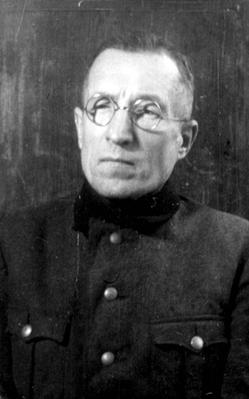
Schwerte is a town in the district of Unna, in North Rhine-Westphalia, Germany.

Aufseherin was the position title for a female guard in Nazi concentration camps. Of the 50,000 guards who served in the concentration camps, training records indicate that approximately 3,500 were women. In 1942, the first female guards arrived at Auschwitz and Majdanek from Ravensbrück. The year after, the Nazis began conscripting women because of a shortage of male guards. In the context of these camps, the German position title of Aufseherin translates to (female) "overseer" or "attendant". Later female guards were dispersed to Bolzano (1944–1945), Kaiserwald-Riga (1943–44), Mauthausen, Stutthof (1942–1945), Vaivara (1943–1944), Vught (1943–1944), and at Nazi concentration camps, subcamps, work camps, detention camps and other posts.
Außenarbeitslager Gerdauen was a subcamp of the Stutthof concentration camp in nowaday's Zheleznodorozhny, Kaliningrad Oblast. Most of the prisoners in the subcamps of the Stutthoff camp contained Jewish women from Hungary and from the Łódź Ghetto, and there were also some Jewish men from Lithuania. While a labor camp rather than a death camp, many people died - of 100 Jewish girls at the camp only three survived the war.

The Esterwegen concentration camp near Esterwegen was an early Nazi concentration camp within a series of camps first established in the Emsland district of Germany. It was established in the summer of 1933 as a concentration camp for 2000 so-called political Schutzhäftlinge and was for a time the second largest concentration camp after Dachau. The camp was closed in summer of 1936. Thereafter, until 1945 it was used as a prison camp. Political prisoners and so-called Nacht und Nebel prisoners were also held there. After the war ended, Esterwegen served as a British internment camp, as a prison, and, until 2000, as a depot for the German Army.

Wolfgang Benz is a German historian from Ellwangen. He was the director of the Center for Research on Antisemitism of the Technische Universität Berlin between 1990 and 2011.
Ernst Stengelin was a German SS-Unterscharführer (Corporal) who served at Treblinka and Sobibor extermination camps and was killed in the Sobibor uprising. Nothing is known about his personal life.

Sonnenburg concentration camp was opened on 3 April 1933 in Sonnenburg in a former prison, on the initiative of the Free State of Prussia Ministry of the Interior and Justice.

Franz Stärfl, alias Xaver Stärfel, alias Franz Stofel, was a Nazi German SS-Hauptscharführer and camp commander of the Kleinbodungen subcamp of Mittelbau-Dora during World War II. Arrested by the Allies and convicted of war crimes in the Belsen Trial, Stärfl was executed by hanging at Hamelin prison in 1945.
Eleonore Baur, also known as "Sister Pia", was an early member of the Nazi Party and the only woman known to have participated in the Munich Beer Hall Putsch.

Anton Thumann was a member of the SS of Nazi Germany who served in various Nazi concentration camps during World War II. After the war, Thumann was arrested by British occupation forces and charged with war crimes. At the Neuengamme Camp Case No. 1 in 1946 he was found guilty, sentenced to death and executed at Hamelin Prison.
Fritz Ritterbusch was a Nazi SS-Haupftsturmführer, a member of the crew of the Hinzert concentration camp, Lublin and Gross-Rosen and others. He was a commander of the Trautenau-Parschnitz camp.

Arnold Büscher was a German SS officer. Holding the rank of SS-Obersturmführer, he served as a commandant of the Kraków-Płaszów concentration camp, succeeding Amon Göth, from September 1944 until January 1945.
Nikolaus Herbet was a German SS officer and the second and last commandant of Warsaw concentration camp, during the period from September 1943 to July 1944. He was preceded in this function by Wilhelm Göcke.
Albert Sauer was a Nazi German commandant of Mauthausen-Gusen concentration camp. He died of wounds in 1945, and was never tried for his role in The Holocaust.

For the former Mayor of Cape Town, see Richard Friedlander (mayor)
Bruno Brodniewicz born 22 July 1895 in Posen, was a German prisoner in the Auschwitz concentration camp. Brodniewicz was the first Lagerälteste, carrying prisoner tag number 1. He died in April 15–16, 1945 in Bergen-Belsen concentration camp.

Kauen was a Nazi concentration camp located in the former Kovno Ghetto. It operated from 15 September 1943 to 14 July 1944 and had seventeen satellite camps located around the city of Kaunas, in modern-day Lithuania. Most prisoners were Jews who had survived the previous years of the Holocaust in Lithuania. In July 1944, eight of the subcamps were closed. The main camp was liberated by the Red Army on 1 August 1944.

The Regensburg satellite camp, also known as the Colosseum subcamp in the vernacular at the time, was established in 1945 as the last subcamp of the Flossenbürg concentration camp in the Regensburg inn the Kolosseum. The Regensburg subcamp was in operation from March 19, 1945, until April 23, 1945. The Colosseum building is located at Stadtamhof 5, approximately 200 meters north of the Danube across the Stone Bridge from the Altstadt.
Kirsten John-Stucke is a German historian, non-fiction author, and museum director of the Wewelsburg Museum. She is the editor of numerous documentations on the history of Wewelsburg during the National Socialist era and on the history of the Niederhagen concentration camp. The focus of her work lies in commemorative culture, educational memorial work, and in the re-conception of the Wewelsburg Memorial and Museum from 1933 to 1945.











